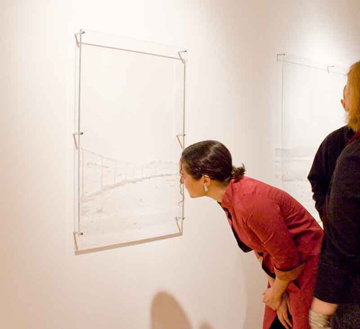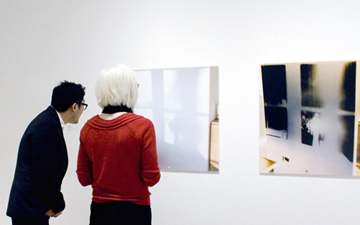Good experience, bad experience. Life experience, work experience. First experience, years of experience. Learning experience. Sensory experience. Out-of-body experience. Shared experience. We experience life in innumerable, and oftentimes indescribable, ways. When Flash Points editor Rachel Craft approached me to write this post, she posed the question, “How do we experience art?” This question, almost as difficult to answer as the familiar “What is art?” (or the similar “Why is this art?”), is one I was preoccupied with while curating the exhibition InVisible: Art at the Edge of Perception.
InVisible marks a first experience for me – my foray into curatorial practice. Shortly before proposing the theme for my exhibition, I read an article that stated that the majority of museum-goers spend, on average, only six seconds looking at art. What kind of experience would one have in such a short period of time? InVisible is a group exhibition of works by six international artists who explore the line between visibility and invisibility and, in so doing, invite us to participate in a deeper, and I hope slower, act of looking. The artists in the show – Uta Barth, Christian Capurro, Joanne Lefrak, Janet Passehl, Jaime Pitarch, and Karin Sander – examine the demands and subtleties of the viewing experience and create art that tests the limits of perception.
Drawing attention to what often goes unnoticed, many of the works in the show heighten our awareness of the inconspicuous details in the artists’ materials or of mundane objects. Some of the works, pushed to the edge of legibility, disappear into the gallery space itself. Several of the artists manipulate ephemeral phenomena, harnessing the potential of light and shadow, while others use strategies of erasure and find the “something” in what might otherwise be described as “nothing.”
For Part One of this blog post, I asked a few of the artists in InVisible how they hope viewers experience their art.
Many of the artists spoke about the temporal aspect associated with viewing art. Uta Barth replied, “Slowly, quietly, alone, and over time. I am interested in getting you to engage in looking rather than losing your attention to thoughts about what you are looking at. I want you to immerse yourself in the experience of looking, to become conscious of your perceptual process, to be in the moment and to then carry this beyond looking at my work and into your own world.” Barth does indeed bring her own world into ours. The photographs that make up the Sundial series chart the effect of the changing qualities of sunlight as it crawls across floors and walls of the artist’s home. Barth inverts the traditional distinctions between foreground and background and instead highlights the unoccupied spaces of our everyday lives.
Janet Passehl responded to the question in a similar way: “Looking should be approached like doing a yoga pose – purposeful but not strenuous. Not detached, but unattached. It’s important to stand before a work for a long time to go through all the phases of looking and apprehending. The intellect does come into it eventually, but that should happen as an evolution of the looking process, not as effortful thinking.” Creating subtle sculptures out of swaths of cloth, the lack of representational imagery in Passehl’s work draws our attention to the often unnoticed characteristics of the texture and weave of the raw material – the cloth itself is the subject of the work. Passehl says she “hopes that people feel confronted by the work’s simplicity and that they can experience my art for how it is more than what it is, what it does, or what it ‘says.’ I hope that each work exists in a kind of equilibrium and that this is felt by the viewer.”
Like Barth and Passehl, Christian Capurro also speaks to art’s ability to transport the viewer to a new space, time, and even psychological state. How should people experience his art? “There is no ideal way. Come curious, forget yourself a little while you’re there, and leave with doubts.” Capurro’s Compress series, six of which are exhibited in InVisible, are created through the pressure of erasing pictures from magazine pages. He lays one page on top of another and, by erasing the top page, imprints images onto the bottom one. In making Compress, Capurro uses the act of erasing as a generative, creative process. Delicate, intricate, and haunting, the works on paper present us with a palimpsest of past and present forms. What we see in these images is perhaps dependent on our own past and present experiences.
Joanne Lefrak reiterates that there is no ideal way in which to view and experience art, and asserts that no two people experience the same work of art in the same way. “Viewers bring so much of their own minds into the viewing process. While factors such as installation, presentation, and curatorial decisions influence how one experiences art, our perceptions alter and influence the experience as well.” In Lefrak’s case, proper lighting is required for a viewer to truly experience the work. Lefrak creates detailed “drawings” using light and shadow. In two new works created for InVisible, light passing through etched Plexiglas sheets casts shadows onto the gallery wall. The lines incised into the Plexi are barely visible, but the shadow’s gradations of gray convey depth and space in almost photographic detail. When the work is not illuminated, the drawing disappears. Lefrak goes on to say that “the infinite nature of seeing and experiencing art is part of what makes art’s ability to transform the viewer (and vice versa) so meaningful.”
What about art’s ability to transform artists? In Part Two of this post, the artists will give us a look at how they experience art. Check back to learn more about the viewing experience and how it may differ for those who create art.
Katia Zavistovski is the Clark Curatorial Intern at MASS MoCA.





Pingback: Come Curious: The Artists Look | Art21 Blog